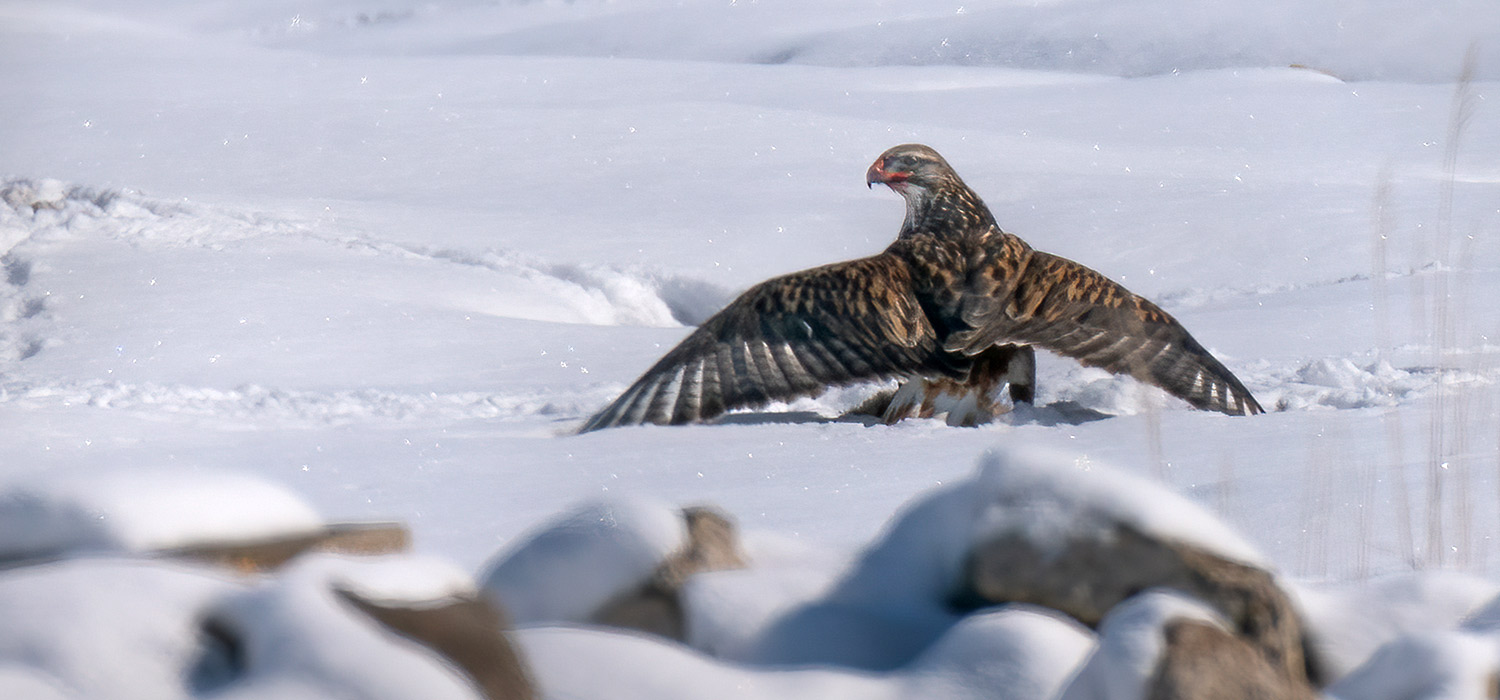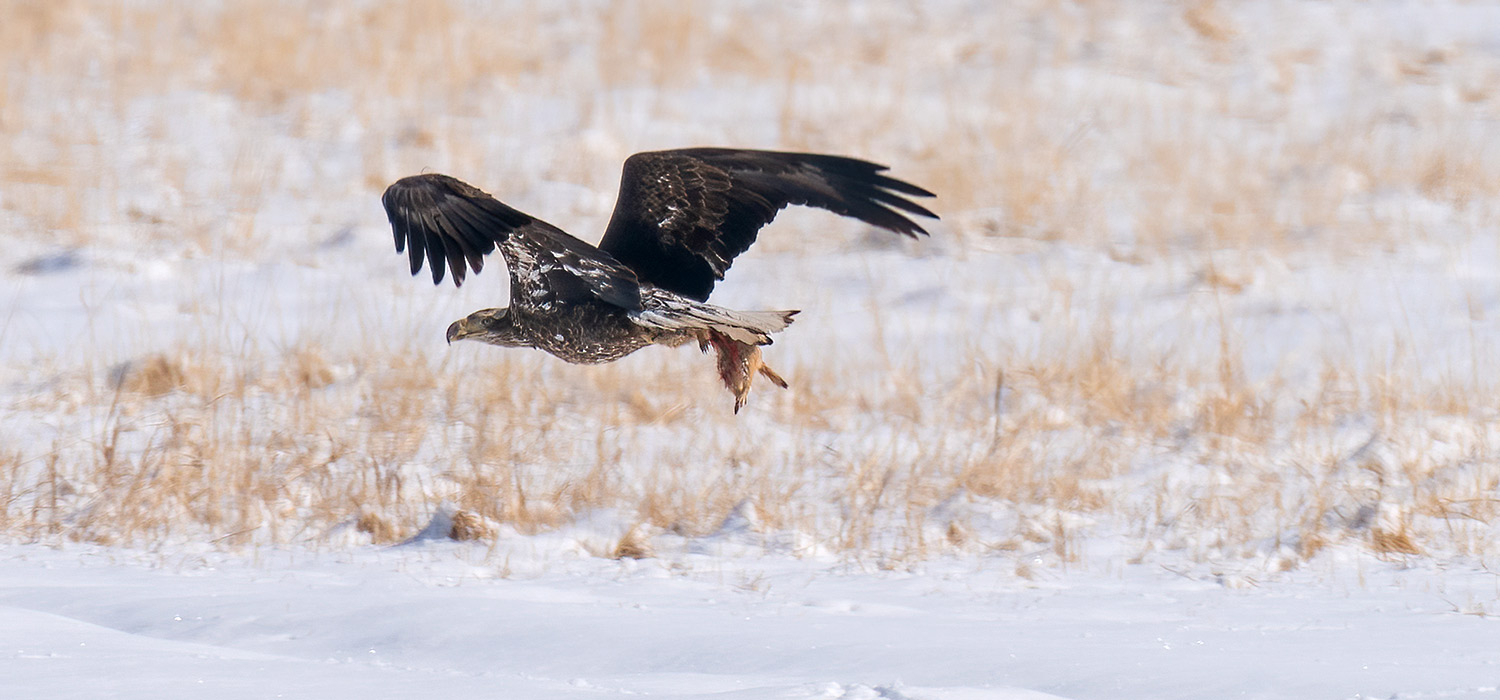Prairie Dogs on the Front Range
March 17, 2022
On a sunny winter’s afternoon in Boulder County, the short grass prairies of the Colorado Front Range are teeming with life. Red tailed hawks and bald eagles can be seen soaring over the prairies and pastures and the sharp squeak of prairie dogs can be heard ringing out over the distant hum of traffic. For one little prairie dog, his day ends abruptly. A ferruginous hawk has struck the entrance of a prairie dog burrow and is retrieving its prey. Once the prey is secured, this lucky hawk begins to eat its catch (Figure 1) with outstretched wings to fend away competitors (Figure 2).

Figure 1: A ferruginous hawk eating a prairie dog in Boulder County, Colorado

Figure 2: A ferruginous hawk takes a break from eating to survey the territory to defend its meal from other raptors.
Unfortunately for this hawk, other raptors have already started to notice this success. A three-year-old bald eagle swoops down to the ground and muscles the prairie dog away, quickly leaping into flight and escaping with an easy meal (Figure 3).

Figure 3: A three-year-old bald eagle flies away with a prairie dog clutched between its talons. Notice how its head feathers are beginning to lighten from dark brown to white. This is one of the ways that we can age bald eagles.
This is not the final chapter of the prairie dog’s journey though. Much to the three-year-old bald eagle’s dislike, a juvenile bald eagle and juvenile golden eagle both join in the fight for the prairie dog. The three-year-old spreads out their wings, ready for battle on the ground, while the juvenile bald eagle jumps into the air screeching with aggression (Figure 4). After an elaborate scuffle between two of the most majestic raptor species on this continent, the juvenile bald eagle is ultimately victorious and escapes with the prairie dog in its talons. In one afternoon, a singular prairie dog passed between the talons of four different raptors.

Figure 4: A juvenile bald eagle (up in the air) and a three-year-old bald eagle (on the ground) fight over the prairie dog.
While prairie dogs are viewed as a nuisance by some, prairie dogs are the life blood of these raptors. Not only are prairie dogs a vital prey source (1), but they are crucial for many other avian and non-avian wildlife in the Colorado Front Range, and are thus considered a keystone species. Their colonies are home to an army of ecological engineers. Prairie dogs are crucial for healthy soil aeration, the dispersal of native plants, and for the creation of homes for many other important species along the Colorado Front Range. Burrowing owls, cottontail rabbits, and countless insects and amphibians rely on prairie dog colonies for shelter (2).
Above ground, prairie dogs alter shrub and grassland composition. By preventing woody shrubs from taking over and promoting the growth of young grasses, prairie dogs help to maintain grassland habitat for short-grass prairie songbirds, as well as raptors. For example, the highly endangered mountain plover, that nests in Weld County, requires the unique habitat that prairie dogs create for their survival (3, 4). Prairie dogs are a requisite food source for a variety of other Colorado birds. As we see daily in our field studies, Colorado Parks and Wildlife (CPW) reports that bald eagles, golden eagles, ferruginous hawks, and red-tailed hawks rely heavily on prairie dogs as a food source, particularly during winter months (5) (Figure 4). Without prairie dogs, we lose the delicate and complex ecosystem that sustains our raptors.
Today, in Boulder County, it feels like a war against prairie dogs for many people—with support from local government for management strategies that ultimately favor agriculture and recreation over wildlife. Last month, on February 10th, 2022, the Boulder County Commissioners agreed to lift a moratorium preventing lethal control of prairie dogs in areas designated as not suitable for prairie dogs during their breeding season. While it was argued that this method of control would ultimately lead to fewer prairie dog deaths, the overall strategy continues to ignore the critical ecological role that prairie dogs play on the Front Range. Prairie dogs are the life blood of these incredible raptors. Perhaps give a second thought the next time you hear that prairie dogs should extirpated.
References
- Barko VA, Shaw JH, Leslie DM Jr.: Birds associated with black-tailed prairie dog colonies in southern shortgrass prairie. The Southwestern Naturalist484-489,1999.
- Boyce A, Dreelin A: Ecologists Dig Prairie Dogs, And You Should Too. Smithsonian’s National Zoo and Conservation Biology Institute.
- Knopf FL, Rupert JR: Reproduction and Movements of Mountain Plovers Breeding in Colorado. Wilson Bull., 108(l), pp. 28-35., 1996.
- Dreitz, VJ, Knopf FL, Morgan K, Morgenweck RO, Sexson T, Nelson L: The Mountain Plover model for ESA conservation on private lands. Paper read at Invited Presentation for the Bird Conservation of North American Shrublands, Grasslands and Pasturelands symposium at the Wildlife Society 12th annual Conference, September 2005, at Madison, Wisconsin. 2005.
- Weber DA: Winter raptor use of prairie dog towns in the Denver, Colorado vicinity. International Urban Wildlife Symposium. 2004.
